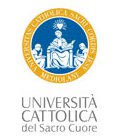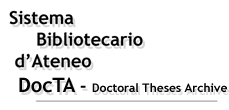|
|
DocTA - Doctoral Theses Archive >
Tesi di dottorato >
CORSO DI DOTTORATO IN CULTURE DELLA COMUNICAZIONE >
Citazione:
Utilizza queste indicazioni per citare o creare un link a questo documento.
|
D'aloia, Adriano. "L'EMPATIA NELL'ESPERIENZA FILMICA", Università Cattolica del Sacro Cuore, XXII ciclo, a.a. 2008/09, Milano, [http://hdl.handle.net/10280/788].
|
| Titolo: | L'EMPATIA NELL'ESPERIENZA FILMICA |
| Autore/i: | D'ALOIA, ADRIANO |
| Tutor: | CASETTI, FRANCESCO |
| Coordinatore: | GRASSO, ALDO |
| Lingua: | ITA |
| Abstract in italiano della tesi: | Negli ultimi decenni i film studies stanno spostando la propria attenzione sul livello corporeo e affettivo dell’esperienza filmica. Adottando un approccio fenomenologico e focalizzandosi sulla nozione di empatia, la tesi studia le strategie del coinvolgimento dello spettatore cinematografico nei film di successo contemporanei. Il capitolo 1 rintraccia le diverse accezioni di empatia in filosofia, estetica, psicologia e nelle neuroscienze cognitive. Il capitolo 2 traccia una genealogia dell’empatia nelle teorie psicologiche ed estetiche del film. Il capitolo 3 esplora la rilevanza della teoria dell'atto empatico di Edith Stein per la filmologia e ne propone un'applicazione allo studio dell’esperienza filmica contemporanea. Il capitolo 4 analizza un ampio corpus di film contemporanei individuando quattro “figure aree” del coinvolgimento filmico: l’acrobazia, la caduta, il volo e il movimento in assenza di gravità. Attraverso la simulazione empatica dei movimenti nel film e del film, lo spettatore esperisce inavvertitamente l’intenzionalità implicata nelle forme e negli oggetti della rappresentazione, cogliendo con la propria sensibilità il senso di un’esperienza che trascende l’immanenza del film e contribuisce al processo di attribuzione di senso al Mondo, all’Altro e al Sé. |
| Abstract in inglese: | In recent decades film studies have shifted their focus to the emotional and bodily level of film experience. By adopting a phenomenological approach, this dissertation deals with the strategies of the film spectator’s involvement in contemporary mainstream narrative films. Chapter 1 reconstructs the meanings of the notion of empathy in philosophy, aesthetics, psychology and neurocognitive research. Chapter 2 traces a genealogy of empathy in film theories, from Bergsonism to Cognitivism, and evaluates the relevance of Simulation-Theory to film studies. Chapter 3 explores the relevance of Edith Stein’s phenomenological theory of empathy to film theory and assumes it is a theoretical model to investigate the “intensified” nature of both film design style and film reception style. A film is constructed and experienced on the basis of the “circuit of empathy”, a stratified system of different species of empathetic interaction, acting at senso-motorial, perceptual, cognitive and emotional levels with the aim of generating both an aesthetic and an inter-subjective experience. Chapter 4 analyses a vast corpus of contemporary films and focuses on four “aerial figures” of involvement and their combination: acrobatics, falling, flying, and non-gravitational movements, both of the actor’s human body and of the film’s anthropomorphic body. In the Conclusions, it is argued that the spectator internally imitates these “double” movements and inadvertently experiences the intentionality implied in the figures. Contemporary film spectators empathetically “get”, with their own sensibility, the senses of an experience that transcends the immanence of the film and contributes to the process of “giving” sense to the World, the Other, and the Self. |
| Data di discussione: | 3-mag-2010 |
| URI: | http://hdl.handle.net/10280/788 |
| È visualizzato nelle collezioni: | CORSO DI DOTTORATO IN CULTURE DELLA COMUNICAZIONE
|
File in questo documento:
| File |
Dimensioni | Formato | Accessibilità |
|---|
| testo completo.pdf | 12,93 MB | Adobe PDF | non consultabile
|
|
Accesso e utilizzo dei contenuti di DocTA
|



